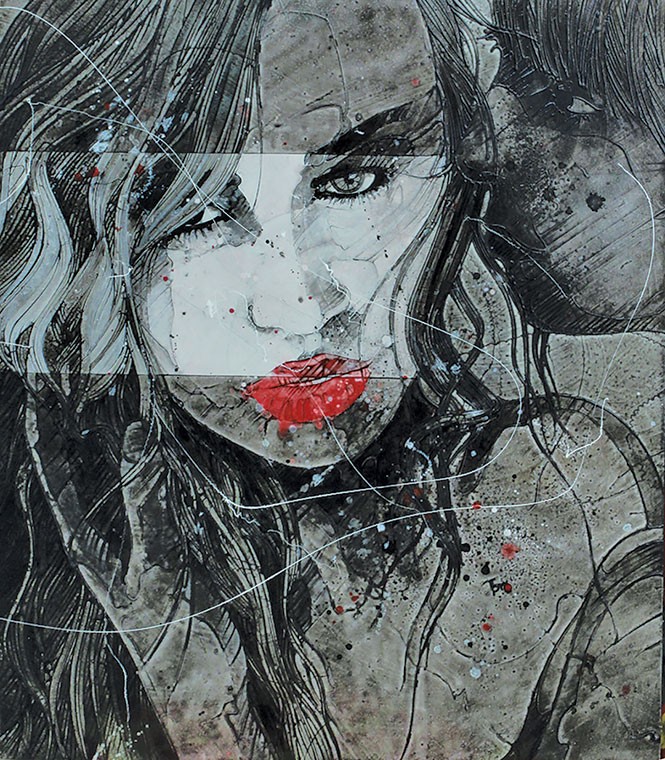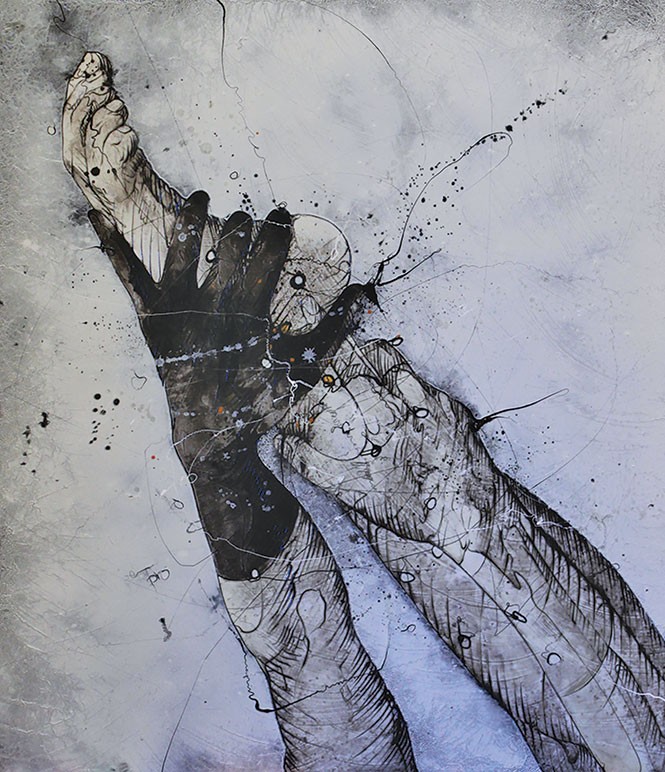
Artists evolve in different ways. Painting is usually thought of as a solitary medium, but local oil painter Jimmi Toro has recently expanded his artistic horizon by collaborating with other artists and adapting his work to other media. Opening at Urban Arts Gallery this month, Art-Music-Video—as the title implies—fuses three art forms to embody Toro's vision of humanity.
The exhibit's six sections provide perspectives on his multifaceted artistic personality. Each one is titled for a song the self-taught musician wrote and recorded, and in each case, the collaborators helped expand on the themes. "Amy Jane" is a fictional tale of substance abuse, in which Toro created a painting of the character, while six local photographers—Heidi Gress, Keith Johnson, Chris Madsen, Cat Palmer, Kim Riley and Alexandra Welcome—produced photographic interpretations. Toro filmed their artistic process. "Soul," a painting with a strip across the eyes—intended to depict "the face of a soul," as an inscription on the painting says—included teenage collaborators from the Kimball Art Center's Young Artists Academy, creating their own versions of the work.
On "I Want to Be," about child abuse, Toro worked with videographer Michael Christensen, who came up with the idea of a box with a child kept in it. "Separation," produced in coordination with Ballet West principal Allison DeBona, used non-ballet dance moves to interpret its theme, with Toro filming her and painting some of the most striking images in the exhibit. "Love—Believe It," (which he said I could punctuate as I saw fit) is a section of 45 small portraits of faces, and "Tell Me Brother" is comprised of several large portraits with one half of the face male, the other female. It calls into question how we define gender, and the often strict boundaries of identity.
In addition to the interaction between artists, these works provide plentiful illustrations of the ways different artistic media influence and inform each other. Toro says his music is influenced by Beck and David Bowie, and the title and subject matter is a nod to the Thin White Duke's Sound + Vision album. Given his virtuoso command of a visual vocabulary that seems to change from one painting to the next, it's slightly startling when he notes "music has an outreach that [visual] art doesn't, and with video, the power of the three together is amazing."
As a cornerstone of the Gateway mall, which has lost a number of stores and foot traffic to City Creek, the Urban Arts Gallery is still a bright spot. The site has always mounted imaginative, fun exhibits, and with old shelving removed, the space no longer has the "gift shop" atmosphere it had in the past. Its open floor plan creates a great space to view art on the walls, and the presentation of this exhibit is striking, one of Urban Arts' best.

Interestingly, the gallery's press release states that in addition to viewing, watching video monitors, listening to the music through headphones and viewing wall-mounted works, guests are invited to touch the paintings, which is usually taboo. But it's not surprising given the artist's desire to make emotional connections with the viewer. Toro's painting style is as breathtaking as a ballerina, and the paint dances across the canvas—stipples, splotches, drips and swirls, and even occasionally forms geometric grids—but the central focus of each one is the human subject, delineated lucidly but also with emotional intensity. The textures created by his layers of paint create a very intriguing tactile experience.
There's a message behind the media in this art show. "I hope to inspire people to be better toward each other," Toro says, as each of the narratives in the show ultimately offers some kind of hope for humanity, and the notion that love can be a saving grace. "There's a lot of art for art's sake, but I hope to produce art that has a little inspiration for people's lives."
It is remarkable, and perhaps slightly hard to believe, that after working on the exhibit idea for years, he produced all these works—including more than 60 paintings—in just the past three months. The artistic process, the struggle to create, is part of his vision of humanity: "A dancer like DeBona makes it look effortless, but there is an agonizing side of being an athlete. That is beautiful as well." His motto could serve as advice for other artists. He has found, "Your greatest teacher is to be prolific; just produce."